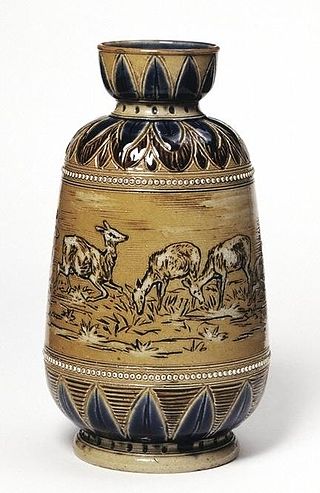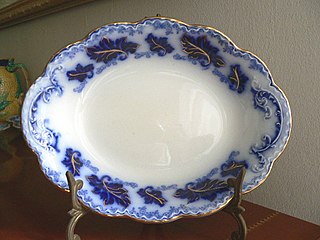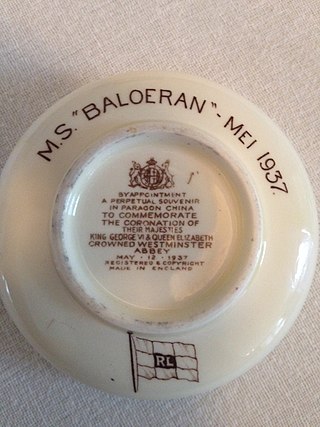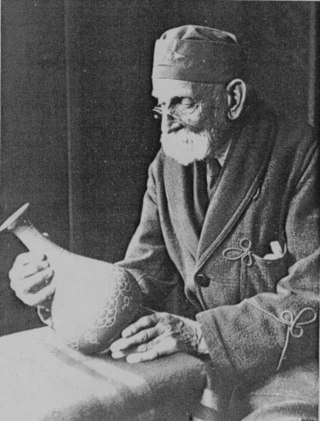

Royal Winton is an English brand of ceramics, made by Grimwades Limited, a Stoke-on-Trent based company founded in 1885. The brand is particularly associated with chintzware.


Royal Winton is an English brand of ceramics, made by Grimwades Limited, a Stoke-on-Trent based company founded in 1885. The brand is particularly associated with chintzware.
The company was founded by Leonard Lumsden Grimwade, an experienced pottery modeller, in 1885; he was joined by his brother Sidney Richard Grimwade, also a potter. By 1906 Grimwades Ltd had four factories in the Potteries, and King George V and Queen Mary visited in 1913. [1]
In 1928 the company began to produce chintzware, floral patterns inspired by textiles of the period. The first pattern was "Marguerite". Soon afterwards the trade name "Royal Winton" was established. Leonard Grimwade died in 1931, and James Plant took over. Over subsequent years, more than sixty chintz patterns were introduced. Because of high production costs, chintzware was discontinued in the early 1960s. [1] [2]
In 1979 the company was acquired by Staffordshire Potteries Ltd, which was bought by Coloroll in 1986. [3] In 1995 the company was bought out by the management; its name reverted to Grimwades Ltd, and traded as Royal Winton. Interest in chintzware had grown, with the publication of reference books and antiques auctions dedicated to it. It was realised that there was a demand for Royal Winton chintz products, so some of the popular designs were reintroduced, reviving old lithographing techniques. The backstamp included the year 1995, to avoid confusion with earlier pieces. In 1997 the first new piece of chintzware since the 1960s was introduced. [1]
In 1999 Grimwades Ltd purchased Duchess China, of Longton in the Potteries, out of administration. [4]

Josiah Spode was an English potter and the founder of the English Spode pottery works which became famous for the high quality of its wares. He is often credited with the establishment of blue underglaze transfer printing in Staffordshire in 1781–84, and with the definition and introduction in c. 1789–91 of the improved formula for bone china which thereafter remained the standard for all English wares of this kind.

Spode is an English brand of pottery and homewares produced in Stoke-on-Trent, England. Spode was founded by Josiah Spode (1733–1797) in 1770, and was responsible for perfecting two important techniques that were crucial to the worldwide success of the English pottery industry in the 19th century: transfer printing on earthenware, and the formula for fine bone china.

Trentham Estate in the village of Trentham, Staffordshire, England, is a visitor attraction on the southern fringe of the city of Stoke-on-Trent.

Bone china is a type of ceramic that is composed of bone ash, feldspathic material, and kaolin. It has been defined as "ware with a translucent body" containing a minimum of 30% of phosphate derived from calcined animal bone or calcium phosphate. Bone china is the strongest of the porcelain or china ceramics, having very high mechanical strength, and is known for its high levels of whiteness and translucency. Its high strength allows it to be produced in thinner cross-sections than other types of porcelain. Like stoneware, it is vitrified, but is translucent due to differing mineral properties.

Wedgwood is an English fine china, porcelain and luxury accessories manufacturer that was founded on 1 May 1759 by the potter and entrepreneur Josiah Wedgwood and was first incorporated in 1895 as Josiah Wedgwood and Sons Ltd. It was rapidly successful and was soon one of the largest manufacturers of Staffordshire pottery, "a firm that has done more to spread the knowledge and enhance the reputation of British ceramic art than any other manufacturer", exporting across Europe as far as Russia, and to the Americas. It was especially successful at producing fine earthenware and stoneware that were accepted as equivalent in quality to porcelain but were considerably cheaper.
Portmeirion is an English pottery company based in Stoke-on-Trent, England. They specialise in earthenware tableware.

Royal Doulton is an English ceramic and home accessories manufacturer that was founded in 1815. Operating originally in Vauxhall, London, and later moving to Lambeth, in 1882 it opened a factory in Burslem, Stoke-on-Trent, in the centre of English pottery. From the start, the backbone of the business was a wide range of utilitarian wares, mostly stonewares, including storage jars, tankards and the like, and later extending to drain pipes, lavatories, water filters, electrical porcelain and other technical ceramics. From 1853 to 1901, its wares were marked Doulton & Co., then from 1901, when a royal warrant was given, Royal Doulton.

Johnson Brothers was a British tableware manufacturer and exporter that was noted for its early introduction of "semi-porcelain" tableware. It was among the most successful Staffordshire potteries which produced tableware, much of it exported to the United States, from the 1890s through to the 1960s. They were also important manufacturers of large bathroom ceramics. Some of its designs, such as "Eternal Beau", "Dawn", "Old Britain Castles" and "Historic America", achieved widespread popularity and are still collected today. The company's success was due in part to its ability to identify and follow trends that appealed to its customers in the United States, and in part to the high quality of its designs, produced by skilled artists.

Mintons was a major company in Staffordshire pottery, "Europe's leading ceramic factory during the Victorian era", an independent business from 1793 to 1968. It was a leader in ceramic design, working in a number of different ceramic bodies, decorative techniques, and "a glorious pot-pourri of styles - Rococo shapes with Oriental motifs, Classical shapes with Medieval designs and Art Nouveau borders were among the many wonderful concoctions". As well as pottery vessels and sculptures, the firm was a leading manufacturer of tiles and other architectural ceramics, producing work for both the Houses of Parliament and United States Capitol.

The Paragon China Company was a British manufacturer of bone china from 1919 to 1960, based in Longton, Stoke-on-Trent, previously known as the Star China Company, and more recently part of the Royal Doulton group. Paragon was noted for producing high quality teaware and tableware, and was granted royal warrants of appointment by several members of the British Royal Family.

A chinaman is a dealer in porcelain and chinaware, especially in 18th-century London, where this was a recognised trade; a "toyman" dealt additionally in fashionable trifles, such as snuffboxes. Chinamen bought large quantities of Chinese export porcelain and Japanese export porcelain landed by the East India Company, who held auctions twice a year in London. The traders then distributed chinaware throughout England.

Aynsley China Ltd. was a British manufacturer of bone china tableware, giftware and commemorative items.
Coloroll is a United Kingdom wallpaper brand owned by CWV Ltd.

California pottery includes industrial, commercial, and decorative pottery produced in the Northern California and Southern California regions of the U.S. state of California. Production includes brick, sewer pipe, architectural terra cotta, tile, garden ware, tableware, kitchenware, art ware, figurines, giftware, and ceramics for industrial use. Ceramics include terra cotta, earthenware, porcelain, and stoneware products.

Shelley Potteries, situated in Staffordshire, was earlier known as Wileman & Co. which had also traded as The Foley Potteries. The first Shelley to join the company was Joseph Ball Shelley in 1862 and in 1896 his son Percy Shelley became the sole proprietor, after which it remained a Shelley family business until 1966 when it was taken over by Allied English Potteries. Its china and earthenware products were many and varied although the major output was table ware. In the late Victorian period the Art Nouveau style pottery and Intarsio ranges designed by art director Frederick Alfred Rhead were extremely popular but Shelley is probably best known for its fine bone china “Art Deco” ware of the inter-war years and post-war fashionable tea ware.

W H Grindley was an English pottery company that made earthenware and ironstone tableware, including flow blue. The company was founded in 1880 by William Harry Grindley, JP of Tunstall, Stoke-on-Trent.
Flux Stoke-on-Trent is a spin-out company from Staffordshire University. Located in Stoke-on-Trent, traditional centre of the English pottery industry, it produces decorated bone china tableware that is manufactured in the city and primarily designed by students on its ceramics master's degree programme.

The Ridgway family was one of the important dynasties manufacturing Staffordshire pottery, with a large number of family members and business names, over a period from the 1790s to the late 20th century. In their heyday in the mid-19th century there were several different potteries run by different branches of the family. Most of their wares were earthenware, but often of very high quality, but stoneware and bone china were also made. Many earlier pieces were unmarked and identifying them is difficult or impossible. Typically for Staffordshire, the various businesses, initially set up as partnerships, changed their official names rather frequently, and often used different trading names, so there are a variety of names that can be found.

Chintzware, or chintz pottery, describes chinaware and pottery covered with a dense, all-over pattern of flowers or, less often, other objects. It is a form of transferware where the pattern is applied by transfer printing as opposed to the more traditional method of painting by hand.

William Ault was an English potter, involved with a number of companies in the Staffordshire potteries and South Derbyshire making art pottery and more utilitarian wares.